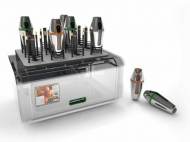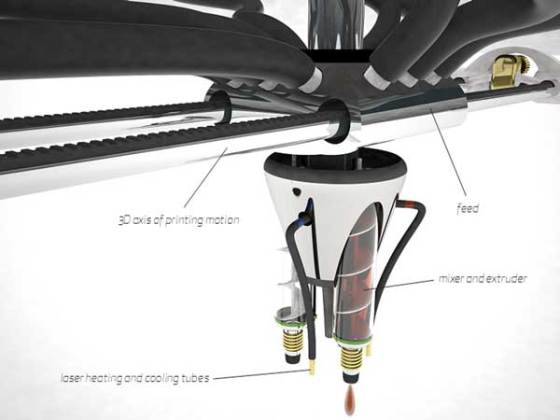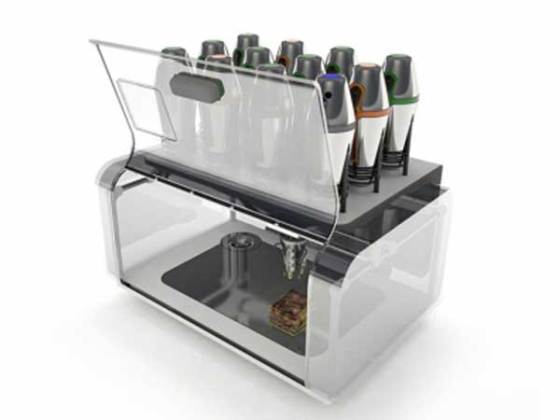Cornucopia: Digital Gastronomy – 3D printer for food
 After writing about 3D printers as Mcor Technologies Matrix 3D printer and Festo iFab, and our emphasis of the potential to create similar machines designed meant for other uses beside rapid prototyping, here is a twist from folks in Fluid Interfaces Group (the group that came up with SixthSense). Cornucopia is a personal food factory that brings the versatility of the digital world to the realm of cooking. In essence, it is a 3D printer for food, which works by storing, precisely mixing, depositing and cooking layers of ingredients.
After writing about 3D printers as Mcor Technologies Matrix 3D printer and Festo iFab, and our emphasis of the potential to create similar machines designed meant for other uses beside rapid prototyping, here is a twist from folks in Fluid Interfaces Group (the group that came up with SixthSense). Cornucopia is a personal food factory that brings the versatility of the digital world to the realm of cooking. In essence, it is a 3D printer for food, which works by storing, precisely mixing, depositing and cooking layers of ingredients.
Cornucopia’s cooking process starts with an array of food canisters, which refrigerate and store a user’s favorite ingredients. These are piped into a mixer and extruder head that can accurately deposit elaborate combinations of food. While the deposition takes place, the food is heated or cooled by Cornucopia’s chamber or the heating and cooling tubes located on the printing head. This fabrication process not only allows for the creation of flavors and textures that would be completely unimaginable through other cooking techniques, but it also allows the user to have ultimate control over the origin, quality, nutritional value and taste of every meal.
Food is stored and fed into Cornucopia through an array of hermetically sealed storage canisters. They contain a broad array of ingredients that allow Cornucopia to print and fabricate a wide range of different meals. Each canister is refrigerated and provides instant feedback to the user of its content. When an ingredient runs outs, Cornucopia can automatically order a new canister or suggest an equivalent ingredient replacement.
Cornucopia’s chamber is outfitted with an array of thermoelectric elements that can precisely heat and cool meals as they are prepared. The ability to hyper-localize heating and create rapid temperature changes also allows for the creation of meals which would be impossible to even imagine with present-day cooking methods.
A user controls Cornucopia through a multi-touch translucent screen, which displays the meal being assembled while allowing the user to manipulate in real-time parameters, such as calories or carbohydrate content. Cornucopia is also intrinsically tied to the web giving it an array of functionalities. For instance, doctors can help monitor the eating patterns of their patients; users can purchase, sell or share their meal inventions with other Cornucopia users; and it can foster local and organic food production by helping users connect with farmers and learn more about where their food comes from and how it is processed.
Designed by Marcelo Coelho and Amit Zoran, it brings the idea of “food slots” or “replicators” seen in Star Trek series. Although we find that this way of food preparing is offering a solution that could lead to the better treatment of the other living organisms around us, there are many issues that need to be solved before we see it in common use. The technology can’t be affordable at first and there is the issue of material distribution and companies that are willing to switch from traditional food serving to the potential nutrition of the future. Besides the fact the technology should be affordable, there is the social aspect where some of the people might find that this way of food preparing is unnatural. On the other hand, our future generations could wonder how we could eat the way we currently do.











Leave your response!